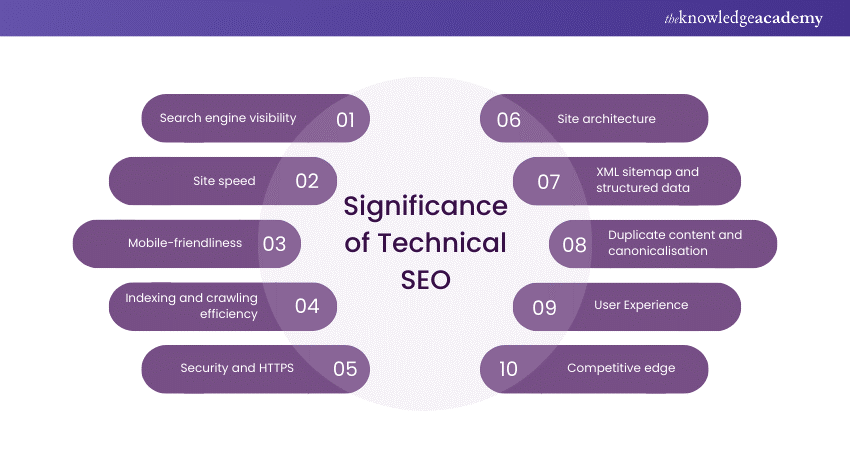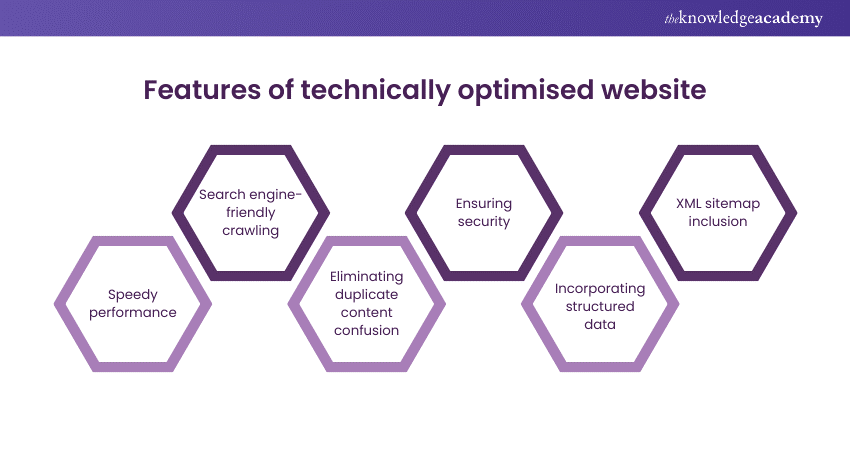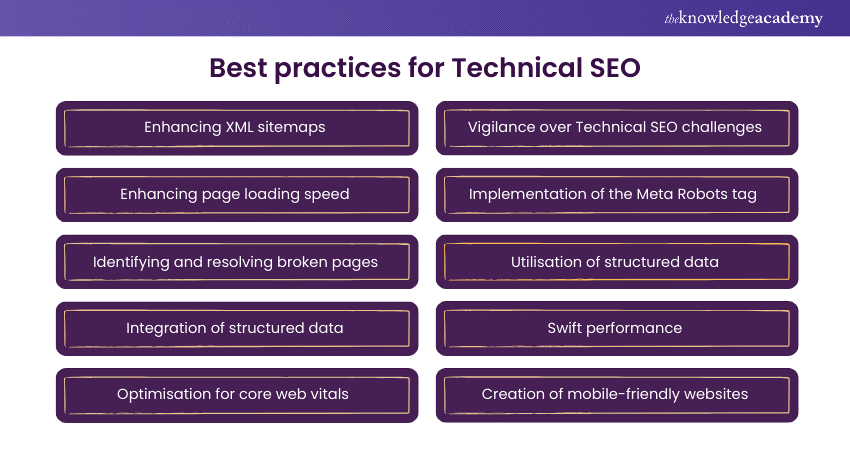We may not have the course you’re looking for. If you enquire or give us a call on 01344203999 and speak to our training experts, we may still be able to help with your training requirements.
Training Outcomes Within Your Budget!
We ensure quality, budget-alignment, and timely delivery by our expert instructors.

If you want a broader audience base for your website or organisation, Technical Search Engine Optimisation (SEO) SEO can prove to be a game changer. But do you know What is Technical SEO? Technical SEO optimises a website’s technical aspects to improve its ranking in the Search Engine Results Pages (SERPs). This branch of SEO focuses on enhancing the infrastructure of a website, ensuring it is efficiently crawled and indexed by search engines. Want to know more about it? Read this blog further to learn What is Technical SEO and how it helps your website rank on search engines. Let's delve in!
Table of Contents
1) Understanding What is Technical SEO
2) The significance of Technical SEO
3) Features of technically optimised website
4) Difference between Technical SEO and SEO
5) Best practices for Technical SEO
6) Conclusion
Understanding What is Technical SEO
Technical SEO optimises a website's technical aspects to help all the search engines crawl and index it more effectively and efficiently. This includes improving site infrastructure and addressing elements that impact a site's visibility in Search Engine Results Pages (SERPs). Significant areas of focus in technical SEO include enhancing site speed, ensuring mobile responsiveness, and securing the site with HTTPS.
Technical SEO also involves optimising site architecture for better navigation and user experience. Thus, it creates an XML sitemap to guide search engines through the site's content, and using structured data to help these search engines understand the content context.
Additionally, it addresses issues like duplicate content, redirects, and canonical tags to prevent confusion for search engines. By optimising these technical elements, websites can improve their chances of ranking higher in search results, leading to increased visibility and traffic.
The significance of Technical SEO
Now, you have an idea about What is Technical SEO, you must understand why do you need it for your business or website? Let’s discuss in detail:

a) Search engine visibility: Technical SEO is crucial for improving a website's visibility on search engines. Optimising technical elements ensures that search engines can efficiently crawl and index the site's content.
b) Site speed: Faster-loading websites rank higher on search engines. Technical SEO optimises site speed, enhances user experience, and reduces bounce rates.
c) Mobile-friendliness: With the rise of mobile users, search engines prioritise mobile-friendly sites. Technical SEO ensures that websites are responsive and provide a seamless device experience.
d) Indexing and crawling efficiency: Proper technical optimisation helps search engine bots crawl and index website pages more effectively. This ensures that all relevant content is included in search engine databases.
e) Security and HTTPS: Search engines favour secure websites. Technical SEO includes implementing HTTPS, enhancing site security, protecting user data, and contributing to better search rankings.
f) Site architecture: Optimising site architecture improves user and search engine navigation. A well-organised structure ensures that critical pages are easily discoverable.
g) XML sitemap and structured data: Creating an XML sitemap aids search engines in understanding the site's structure, while structured data markup provides context, improving the chances of rich snippets in the search results.
h) Duplicate content and canonicalisation: Technical SEO addresses issues like the same content, canonical tags, and redirects, preventing confusion for search engines and maintaining content integrity.
i) User Experience: Technical optimisation contributes to a positive user experience that leads to higher audience satisfaction and engagement, which can indirectly impact search rankings.
j) Competitive edge: Websites with strong technical SEO foundations have a competitive advantage, as they are more likely to rank higher, attract organic traffic, and establish authority in their industry.
Features of technically optimised website
Here are some features of technically optimised website:

1) Speedy performance
Speedy performance is a critical component of a technically optimised website. It refers to the time it takes for a webpage to load and become interactive for the user. Faster websites provide a better user experience, crucial in retaining visitors and reducing bounce rates.
From a Technical SEO perspective, speedy performance impacts search engine rankings. Search engines, like Google, prioritise websites that load quickly, as they help the users to have a better experience. Various factors contribute to site speed, including server response time, image optimisation, efficient coding, and minimising HTTP requests.
Techniques to enhance site speed include optimising images, leveraging browser caching, reducing redirects, minifying CSS, JavaScript, and HTML, and using Content Delivery Networks (CDNs). Additionally, implementing lazy loading for images and videos can significantly improve load times by loading these elements only as they are about to enter the viewport.
Web Developers and SEO professionals often use tools such as Google's PageSpeed Insights, GTmetrix, or WebPageTest to analyse and improve website performance. These tools provide insights into how well a site performs and offer specific recommendations for improvement.
2) Search engine-friendly crawling
Search engine-friendly crawling is about making a website easily understandable and accessible to search engine bots. Crawling refers to the process by which search engines discover and index web pages. For a website to rank well in search engine results, it's essential that search engines can efficiently crawl and understand its content.
Technical factors influencing search engine-friendly crawling include a clean and clear site structure, proper use of robots.txt files, and efficient internal linking. A well-organised website with a logical hierarchy facilitates more straightforward navigation for users and search engine bots. Robots.txt files guide search engines on the pages they need to crawl and which to ignore, ensuring that only relevant and valuable content is indexed.
Additionally, utilising SEO-friendly URL structures and avoiding deep nesting of pages can improve crawlability. It's essential to ensure that critical content is visible from forms or requires user interactions to be displayed, as this can hinder search engines from accessing the content.
Regularly monitoring and fixing crawl errors, broken links, and redirect issues is also crucial. Tools like Google Search Console can be used to identify and resolve such problems and help search engines crawl and index the site effectively.
3) Eliminating duplicate content confusion
Duplicate content is blocks of content within or across domains that completely match or are similar to other content. Search engines, like Google, may penalise sites with a lot of duplicate content as it can manipulate search rankings and degrade the user experience.
Duplicate content issues can arise in various scenarios, such as with printer-friendly pages, HTTP and HTTPS site versions, or www and non-www versions of URLs. Additionally, e-commerce sites often face duplicate content issues with product descriptions that appear on multiple pages.
To eliminate duplicate content confusion, it's essential to use canonical tags. A canonical tag (rel="canonical") tells search engines which version of a page is preferred. This prevents search engines from penalising your site for duplicate content and ensures that the right page is indexed.
Implementing 301 redirects is another strategy to address duplicate content. It is beneficial when consolidating pages or migrating to a new domain. It helps in directing both users and search engines to the correct page.
Regular audits of website content can help identify duplicate content issues. Tools like Copyscape or Siteliner can be used to find instances of the same content across the web. Once identified, appropriate measures like setting up canonical tags or redirects can be implemented.
4) Ensuring security
Ensuring security is a crucial aspect of technical SEO and involves protecting a website from cyber threats and safeguarding user data. A secure website builds trust among users and is also favoured by search engines. Google, for instance, has made HTTPS a ranking signal, prioritising websites that encrypt data transmitted over the internet.
The primary method of ensuring website security is through the implementation of Hypertext Transfer Protocol Secure (HTTPS), which uses Secure Socket Layer (SSL) or Transport Layer Security (TLS) protocols to encrypt data. This encryption is crucial for protecting sensitive information, such as personal and payment information, from interception by third parties.
Besides implementing HTTPS, website security can be enhanced through regular software updates, strong password policies, secure hosting, and employing security plugins or tools. It's essential to scan for vulnerabilities and address them promptly and regularly. Websites should also have measures to prevent common security threats like SQL injection, Cross-site Scripting (XSS), and Cross-site Request Forgery (CSRF).
Search engines may penalise or even blacklist websites that are compromised or deemed unsafe. Therefore, maintaining high-security standards is essential for user trust and safety and for maintaining and improving search engine rankings.
5) Incorporating structured data
Incorporating structured data is a crucial element of technical SEO, enabling search engines to understand better and display a website's content. Structured data refers to a particular format for giving information about a page and classifying its provided content, for example, using schema.org vocabulary.
Structured data helps create rich snippets, which are enhanced search results with additional information like ratings, images, and prices. These snippets make your website more appealing in search results, potentially increasing click-through rates.
Implementing structured data involves using formats like JSON-LD, Microdata, or RDFa to annotate elements on a webpage. This markup provides context to the content, enabling search engines to classify it accurately. For example, for an e-commerce site, structured data can label products, prices, and reviews, making this information directly accessible in search results.
Google's rich results test and structured data testing tool can be used to validate structured data and see how it might appear in search results. Regularly updating and testing structured data is essential to ensure that it aligns with the current guidelines of search engines.
Incorporating structured data enhances the representation of a website in search results, providing a competitive edge and improving user engagement. It plays an important role when search engines interpret and display website content, making it a vital aspect of technical SEO.
6) XML sitemap inclusion
An XML sitemap lists a website's most important pages, ensuring search engines can find and crawl them all. It's essential for websites with many pages, new websites with few external links, deep architectures, or rich media content. An XML sitemap acts as a map for different search engines, providing them with the structure of the site and the relative importance of pages.
It helps search engines discover new pages and updates to existing ones, making it an essential tool for website indexing. Creating an XML sitemap involves listing the URLs of a website, which also has additional metadata about each URL, like the date when it was last updated, how quickly it changes, and its vital relative to other URLs on the site). After this, the sitemap can be submitted to search engines through their respective webmaster tools (e.g., Google Search Console).
It's essential to keep the XML sitemap up-to-date and free from errors, such as listing URLs that redirect or return a 404 error. A dynamic XML sitemap that automatically updates when new pages are added can be particularly beneficial for large or rapidly changing websites.
Do you want to learn more about Digital Marketing? Register now for our Digital Marketing Courses today!
Difference between Technical SEO and SEO
Let’s look at some differences between Technical SEO and SEO:
|
Aspect |
Technical SEO |
SEO |
|
Focus |
Optimising website infrastructure for search engine crawling and indexing |
Enhancing all aspects of a website to improve its search engine ranking, including content, user experience, and off-page elements |
|
Key elements |
Site speed, mobile-friendliness, crawlability, indexing, site architecture, security |
Keyword optimisation, content quality, backlinks, user engagement, social signals |
|
Objective |
Ensure search engines can effectively access, crawl, index, and interpret the website |
Increase a website's visibility and ranking for relevant searches, driving organic traffic |
|
Techniques |
Implementing HTTPS, improving site loading times, creating XML sitemaps, structured data markup |
Creating high-quality content, conducting keyword research, building backlinks, optimising meta tags |
|
Impact on search engines |
Primarily affects a website's ability to be crawled and indexed by search engines |
Affects how search engines rank a website in search results based on relevance and authority |
|
User experience |
Indirectly affects user experience by improving site speed and security |
Directly aimed at improving user experience through valuable content, easy navigation, and engaging design |
|
Tools used |
Google PageSpeed Insights, Google Search Console, Screaming Frog, SSL checkers |
Google Analytics, SEMrush, Ahrefs, Moz, keyword research tools |
|
Responsibility |
Typically falls under web developers and technical SEO specialists |
Involves SEO specialists, content creators, marketers, and social media managers |
Best practices for Technical SEO
Now you know why Technical SEO is important for your website. If you want to know some more ways to use it, read this below:

1) Enhancing XML sitemaps
An effective XML sitemap is crucial for Search Engine Optimisation. It should accurately represent the website's current structure, including all necessary pages. Regular updates are essential, especially after adding new content or making structural changes.
The sitemap must be free of errors, such as URLs leading to 404 pages, and should prioritise high-value pages. Submitting the updated sitemap to search engines through their respective webmaster tools helps ensure that the latest version of the site is indexed promptly.
2) Enhancing page loading speed
Improving page loading speed is vital for user experience and search engine rankings. This can be achieved by optimising images, minimising HTTP requests, leveraging browser caching, and using Content Delivery Networks (CDNs). Also, reducing server response time and optimising CSS and JavaScript can significantly speed up page loading. Regularly testing the website's speed using tools like Google PageSpeed Insights provides insights for continuous improvements.
3) Identifying and resolving broken pages
Regularly scanning the website for broken pages and fixing them is crucial. Broken pages (404 errors) harm user experience and SEO. Utilising tools like Google Search Console or Screaming Frog SEO Spider helps identify these issues. Redirecting broken pages to relevant content using 301 redirects or fixing the links ensures a smooth user experience and maintains link equity.
4) Integration of structured data
Incorporating structured data using schema markup helps search engines understand the content and context of a website's pages. This can improve search results, including rich snippets, enhancing click-through rates. Regularly updating and testing the structured data using tools like Google's structured data testing tool ensures it meets the latest search engine standards.
5) Optimisation for core web vitals
Optimising for Core Web Vitals, Google's metrics for user experience is essential. These include Largest Contentful Paint (LCP), First Input Delay (FID), and Cumulative Layout Shift (CLS). Improving these factors enhances the overall user experience and positively affects search engine rankings. This involves optimising images, minimising JavaScript, and ensuring a stable page layout.
6) Vigilance over Technical SEO challenges
Staying vigilant about emerging Technical SEO challenges is critical. This includes regularly monitoring and adapting to search engine algorithm updates, keeping up with best practices, and addressing new issues. Regular website audits help identify and address technical issues before they impact rankings.
7) Implementation of the Meta Robots tag
The Meta Robots tag should be implemented appropriately because it is essential for controlling how search engine bots crawl and index website pages. This tag can prevent the indexing of duplicate or irrelevant pages, helping to optimise the website's crawl budget and focus on important content. Regularly reviewing and updating these tags ensures they align with the current SEO strategy.
8) Utilisation of structured data
Using structured data effectively enhances how search engines interpret and display website content. Implementing relevant schema markups for articles, products, events, and more ensures that search engines can present this data in rich results, potentially increasing visibility and click-through rates. Regular testing and validation are essential to ensure compliance with search engine guidelines.
9) Swift performance
Maintaining swift performance is a continuous process. This involves initial optimisations for speed and ongoing monitoring and improvements. Critical practices include keeping track of site performance metrics, staying updated with the latest web development technologies, and promptly addressing any slowdowns. Swift performance significantly improves user experience and search engine ranking.
10) Creation of mobile-friendly websites
In an increasingly mobile-dominated world, creating mobile-friendly websites is essential. This includes a responsive design that adapts to various screen sizes, optimising loading times for mobile devices and ensuring easy navigation and readability on smaller screens. Mobile-friendliness improves user experience and is a vital ranking factor for search engines. Regular testing on different devices ensures consistent performance across platforms.
Enhance your knowledge of Social Media Marketing with our Social Media Marketing Course!
Conclusion
We hope that from this blog, you understand What is Technical SEO” and how it plays a significant role in building a company’s audience base. From this blog, we hope you also know that it focuses on improving site infrastructure like speed, crawlability, and security, ensuring search engines can efficiently access and index content, ultimately leading to an enhanced user experience and higher search rankings.
Become more proficient in Google Analytics with our Google Analytics Certification Course today!
Frequently Asked Questions

Technical SEO involves optimising website infrastructure for better search engine performance. Key factors include site speed, mobile responsiveness, crawlability, indexation, site architecture, security (HTTPS), structured data implementation, XML sitemap creation, and duplicate content handling.

To improve Technical SEO, focus on enhancing site speed, ensuring mobile-friendliness, and securing the website with HTTPS. Optimise crawlability and indexation through a well-structured XML sitemap and efficient site architecture. Implement structured data for better understanding by search engines and audit the site to fix technical issues.

Steps for Technical SEO include auditing your website to identify issues, optimising site speed and mobile responsiveness, ensuring a secure HTTPS connection, improving crawlability with a well-structured XML sitemap, implementing structured data, and managing duplicate content. Regularly monitor and update these elements to maintain optimal technical health and search engine performance.

The Knowledge Academy takes global learning to new heights, offering over 30,000 online courses across 490+ locations in 220 countries. This expansive reach ensures accessibility and convenience for learners worldwide.
Alongside our diverse Online Course Catalogue, encompassing 17 major categories, we go the extra mile by providing a plethora of free educational Online Resources like News updates, Blogs, videos, webinars, and interview questions. Tailoring learning experiences further, professionals can maximise value with customisable Course Bundles of TKA.

The Knowledge Academy’s Knowledge Pass, a prepaid voucher, adds another layer of flexibility, allowing course bookings over a 12-month period. Join us on a journey where education knows no bounds.

The Knowledge Academy offers various Digital Marketing Courses, including SEO courses, Google Ads Certification courses, and Pinterest Marketing courses. These courses cater to different skill levels, providing comprehensive insights into SEO methodologies.
Our Business Skills blogs covers a range of topics related to SEO, offering valuable resources, best practices, and industry insights. Whether you are a beginner or looking to advance your Technical SEO skills, The Knowledge Academy's diverse courses and informative blogs have you covered.
Upcoming Digital Marketing Resources Batches & Dates
Date
 Digital Marketing Course
Digital Marketing Course
Fri 24th Jan 2025
Fri 28th Mar 2025
Fri 23rd May 2025
Fri 25th Jul 2025
Fri 26th Sep 2025
Fri 28th Nov 2025







 Top Rated Course
Top Rated Course



 If you wish to make any changes to your course, please
If you wish to make any changes to your course, please


